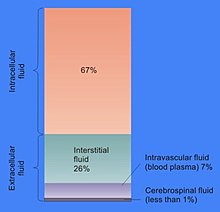
Back سوائل الجسم Arabic Tjelesna tečnost BS Líquid corporal Catalan Tělní tekutiny Czech Körperflüssigkeit German Fluido corporal Spanish Kehavedelik Estonian مایعات بدن Persian Liquide biologique French Fluído corporal Galician
This article about biology may be excessively human-centric. |

Body fluids, bodily fluids, or biofluids, sometimes body liquids, are liquids within the body of an organism.[1] In lean healthy adult men, the total body water is about 60% (60–67%) of the total body weight; it is usually slightly lower in women (52–55%).[2][3] The exact percentage of fluid relative to body weight is inversely proportional to the percentage of body fat. A lean 70 kg (150 lb) man, for example, has about 42 (42–47) liters of water in his body.
The total body of water is divided into fluid compartments,[1] between the intracellular fluid compartment (also called space, or volume) and the extracellular fluid (ECF) compartment (space, volume) in a two-to-one ratio: 28 (28–32) liters are inside cells and 14 (14–15) liters are outside cells.
The ECF compartment is divided into the interstitial fluid volume – the fluid outside both the cells and the blood vessels – and the intravascular volume (also called the vascular volume and blood plasma volume) – the fluid inside the blood vessels – in a three-to-one ratio: the interstitial fluid volume is about 12 liters; the vascular volume is about 4 liters.
The interstitial fluid compartment is divided into the lymphatic fluid compartment – about 2/3, or 8 (6–10) liters, and the transcellular fluid compartment (the remaining 1/3, or about 4 liters).[4]
The vascular volume is divided into the venous volume and the arterial volume; and the arterial volume has a conceptually useful but unmeasurable subcompartment called the effective arterial blood volume.[5]
- ^ a b "body fluid". Taber's online – Taber's medical dictionary. Archived from the original on 2021-06-21. Retrieved 2021-06-22.
- ^ "The water in you". Howard Perlman. December 2016.
- ^ Lote, Christopher J. Principles of Renal Physiology, 5th edition. Springer. p. 2.
- ^ Santambrogio, Laura (2018). "The Lymphatic Fluid". International Review of Cell and Molecular Biology. 337: 111–133. doi:10.1016/bs.ircmb.2017.12.002. ISBN 9780128151952. PMID 29551158.
- ^ Vesely, David L (2013). "Natriuretic Hormones". Seldin and Giebisch's the Kidney: 1241–1281. doi:10.1016/B978-0-12-381462-3.00037-9. ISBN 9780123814623.